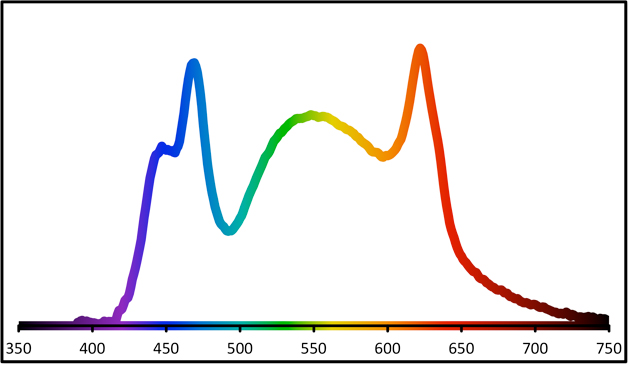Ultraviolet and Infrared Output in ETC LED Luminaires
ETC periodically receives questions regarding ultraviolet (UV) and infrared (IR) output from its LED-based lighting. The motivations behind the questions vary, but the answer is simple: There is no UV or IR light produced by any of ETC’s LED fixtures.
What’s the difference between UV, IR, and visible light?
The lines between the visible spectrum and the edges of both UV and IR light are somewhat fishy. Different scientific and industry publications define different boundaries or border wavelengths. In general UV is said to begin at wavelengths lower than 380-400nm. IR includes wavelengths longer than about 800nm.
Why does UV and IR radiation matter?
Usually, the question of UV and IR light has to do with concerns about light-related damage on sensitive objects:
“Will the light fade antique dyes and inks?”
“Will sensitive fibers and fabrics break down more quickly under this light?”
“Will certain pigments and paint media turn yellow or brown after exposure to this light?”
UV light, being higher-energy than visible light, does carry an increased potential for damage. It's essential to bear in mind, however, that light of any wavelength has the potential to damage sensitive objects. Remember, it's all just electromagnetic energy. Wavelength plays a role, but damage is also directly tied to the idiosyncratic sensitivities of any object being illuminated. Different dyes, pigments, fibers, etc. all have their own, unique spectra of wavelengths that harm and wavelengths that are less damaging.
What about filtering?
A UV or IR filter would have no beneficial effect on ETC LED luminaires. Since there is negligible light in that range to begin with, a filter would effectively just cut the output of light in the visible range. A more productive exercise would be to carefully assess brightness levels and mitigate exposure time.
For especially sensitive and valuable objects, it is essential to consider which visible wavelengths the piece is most vulnerable to. The differences from piece to piece can be surprising.
What is the range of output from ETC’s LED fixtures?
Light output from ETC’s LED fixtures drops significantly on either side of the range between about 430 and 650nm, well inside the visible spectrum.

Above is a spectral power distribution for Source Four LED Studio HD, which includes LEDs at both far ends of the spectrum. The outer limits of this spectrum represent the limits for a typical LED fixture. The output falls to zero very far from either the UV or the IR range. The small bumps at the tail ends of both sides of the spectrum are digital noise from the spectrometer used to characterize the output; they are not measured light.
Is LED-based lighting safe?
Having no UV or IR does not mean that a light is universally safe. All it really means is that there is no invisible energy being produced, energy that can harm an object without providing any illumination benefit. In other words, neither IR nor UV contributes anything to visibility; they offer zero lighting bang for the potential damage buck. ETC’s LED-based light fixtures produce no UV and IR output. Whether that makes them safe is a matter of brightness, exposure time, the objects being illuminated, and a dose of common sense in their application.
